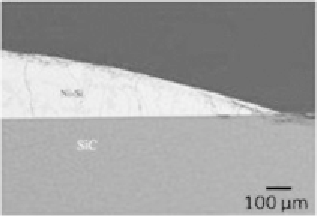Biomedical Engineering Reference
In-Depth Information
(a) (b)
Figure 18.
Cross-section SEM micrographs (BE mode) of the Ni-Si56/SiC couples at (a) 1100
◦
Cand
(b) 1350
◦
C, showing the non-reactive wetting characteristics and some cracks formed during cooling.
The white and gray phases in the drop are NiSi and NiSi
2
, respectively.
(NiSi and NiSi
2
)
and to the thermal expansion coefficient difference between the
Ni-Si alloy and SiC.
3. Remarks
The high temperature studies of the interactions between molten alloys with ce-
ramic materials, have shown that the dissolution phenomena, occurring between
the molten pure metal and the ceramic, can be nearly completely suppressed by
ad-hoc additions of a second element which saturates the molten phase. This result
and the interpretation of the complex phenomena occurring at high temperatures
between the molten phase and the ceramic substrate (dissolution, reaction as well
as the formation of new phases during the solidification process), are made possible
by using reliable phase diagrams of the ternary and higher-order systems, which
can be computed on the basis of known thermodynamic quantities using advanced
databases and dedicated softwares.
The resulting isothermal sections and the isopleths connecting the ceramic com-
position to that of the filler alloy permit a deeper understanding of the experimental
phenomena observed both during the wetting tests and in the cooling process.
E. Experimental Techniques for High Temperature Wettability
Measurements
Surface tension and wettability measurements at high temperature are increasingly
requested to characterize the behavior of systems of industrial interest, both to
define precisely their thermophysical properties to be used in the modelling of
production processes and to determine their behavior in highly aggressive envi-
ronments, be them of chemical or mechanical origin.
Good suggestions and rules to observe when setting up a measurement apparatus
(furnaces, optical lines, data acquisition, etc.) or when designing a series of specific
tests can be found in specialized topics and papers [1, 54, 91, 131, 207].


Search WWH ::

Custom Search